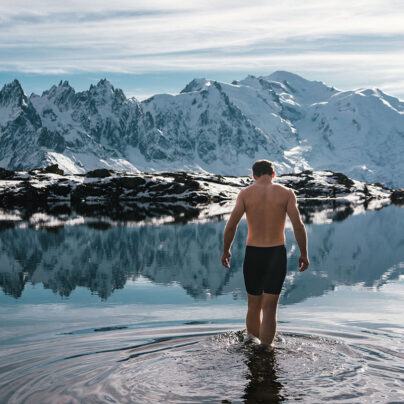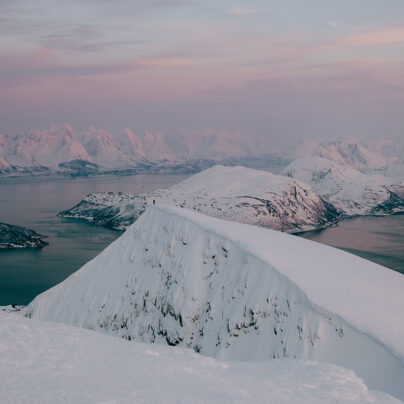Crossing Iceland
Will Copestake
for two days we plodded along the road, with a heavy pack pounding my feet into the hard tar I was soon developing huge blisters, my muscles ached and with a roaring gust of wet spray trucks would douse us as we past. I couldn’t wait to leave the trail and into the wild.
False Start
Three days after landing I was standing with Remi watching the dust settling onto an empty road. Our lift which we had hitched to the southern corner at Kötlutangi had left, we were alone. Stretching out before us an impossibly flat expanse of coal black ash struck a sharp contrast to the lush spring greenery of the Scottish Highlands. With each step toward the coast a puff of what was recently the top of Eyjafjallajokull filled the air around our feet, the ash turning from black to gold in the unsetting Icelandic sun.
It was early June, the summer was upon us and eager to hike as planned Remi and I had decided to begin our journey despite local advice that a cold season might cause difficulties inland. Naive…perhaps, but we felt fit and confident. Little did we know it was to become the coldest spring Iceland had experienced in 59 years.
With the eager spring in our step weighted down with packs weighing close to 30kg we left the Atlantic and begun to head north west. To avoid crossing a glacier we would hike 50km along the hard and punishingly straight Route 1 highway which circumnavigates the country, we would then turn inland at the beautiful Skogarfoss waterfall and into the barren interior.
So for two days we plodded along the road, with a heavy pack pounding my feet into the hard tar I was soon developing huge blisters, my muscles ached and with a roaring gust of wet spray trucks would douse us as we past. I couldn’t wait to leave the trail and into the wild. At last! A 60m curtain of pure white plummeted from ashen gargoyled cliffs ahead, we had reached Skogarfoss waterfall! Dropping packs and clambering into two outdoor sinks we soaked our feet in the sulfurously warm water much to the bemused looks of many a tourist. With a last glance backward to bid the road goodbye we started to ascend, to the inland we go!
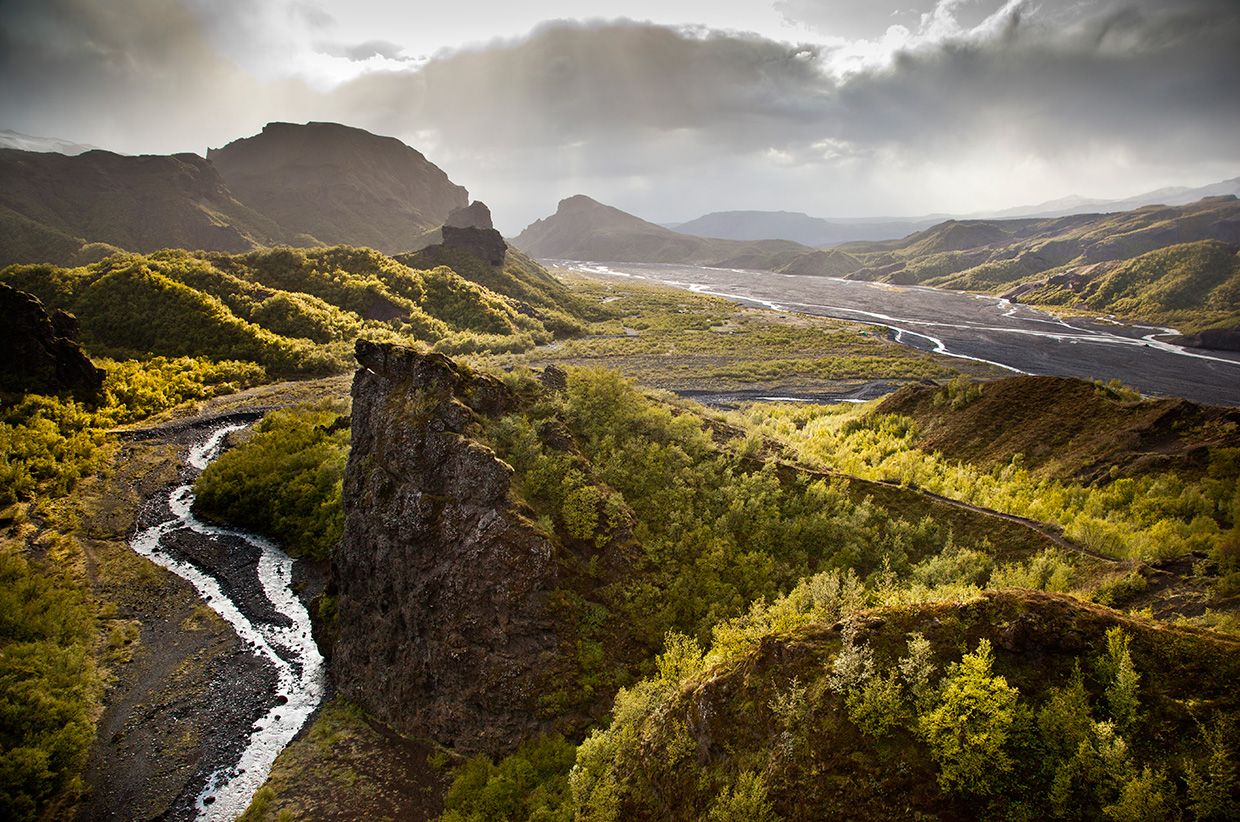
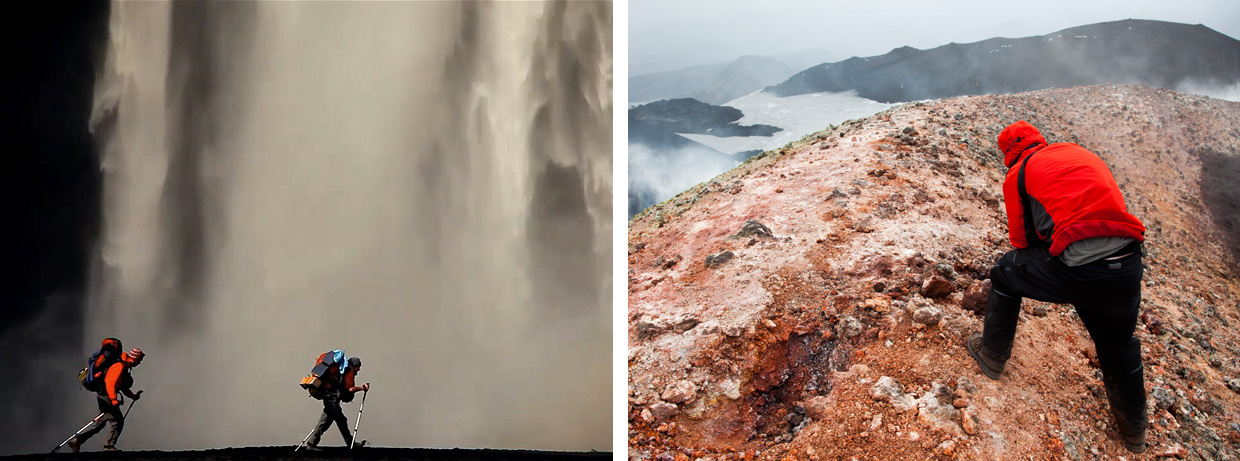
Reaching the col we experienced our first taste of Iceland’s schizophrenic weather, within minutes the still warm day turned into a harsh gale. Pounded with hail and against deafening wind we leant forward and started to descend. Through the storm a strange small and vibrantly colored hill stood proud against the snow, at first I thought it was mist blowing fast from its summit. I was wrong…the mountain was hot! Between cracks in the hills red, yellow and purple rocks a deep red glow rose upward against the elements, this was the 6 month old mountain called Modi. Named after the son of the Norse god Thor in reflectance of the valley below (Þórsmörk…Thor’s Valley) the unassuming hill was one of the youngest places on earth. Bent against the wind Remi and I stood upon its summit, beneath our feet it rumbled! Needless to say after grabbing our packs we then left in haste.
Finally into the shelter of Þórsmörk valley itself the weather returned to the tranquil state we experienced that morning. Golden light lit the last remnant curtains of rain and precious rays of sun warmed up our soaking gear, to my relief my sleeping bag almost dried out before bed. I vowed from then on to ALWAYS double dry bag.
Entering the world famous Laugarvegur trail we were still confident that we could continue despite the weather. Wading across swollen rivers of freezing silty outwash we hiked onward inland. At this time of year the normally popular trail was left almost to ourselves. We were passed by two groups as we walked…both had turned back. The reason why soon became clear, 15km from Þórsmörk valley we were confronted with an impassable torrent, a tremendous rapid which boiled and frothed angrily crossed our path. There was no way around, not even by truck. It would seem the local advice had been right.
Wet, cold and disheartened we turned tail and hiked back toward the coast. We vowed to return in a month when the snowmelt had hopefully subsided. To keep busy and become more familiar with the Icelandic landscape and climate Remi and I waited by hitch-hiking around Iceland, exploring the coast and mountains and venturing into the remote western fjords.
Mid July, bouncing in the back of a 4 x 4 jeep I stared out from behind dusty windows. In the distance the familiar jagged and imposing peaks at the head of Þórsmörk prodded from glaciers. Crossing the intricately braided rivers which flowed from the last remnants of the seasonal melt it was comforting to see a clear difference to what we had seen a month before. The water was low, the waiting was over! Deep down I was both exited and nervous, this time I knew more what to expect of the Icelandic interior but a little voice called out “what if we failed again?”
Wading across swollen rivers of freezing silty outwash we hiked onward inland. At this time of year the normally popular trail was left almost to ourselves. We were passed by two groups as we walked… both had turned back.
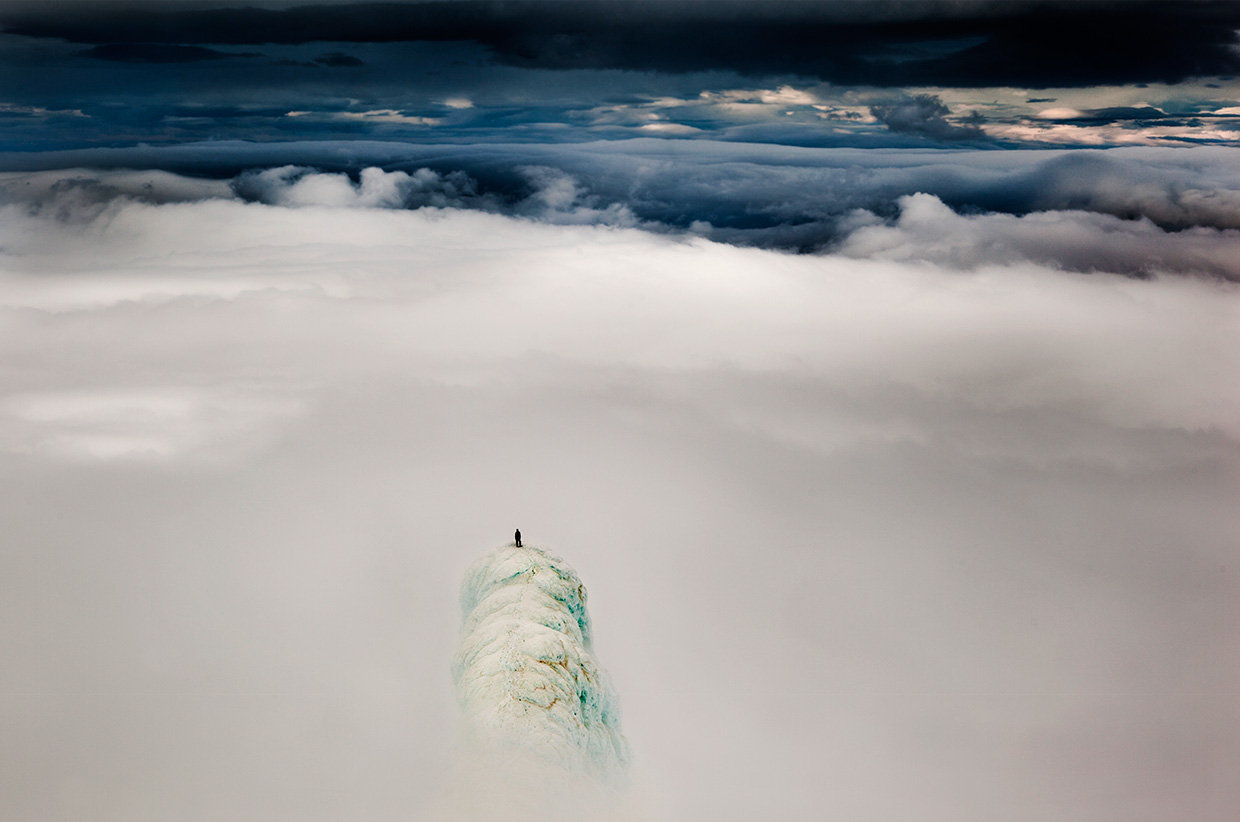
Laugavegur Trail
We had broken our crossing into stages, divided by three re-supply points where rations had been shipped on local buses. Our first took us from the coast to Landmannalaugar which we had half completed on our first attempt, the second 11 days later at Askja and our final re-supply was Lake Myvatn in the north…the home run. Back on the now relatively busy Laugarvegur trail we joined eager hikers across the expanses of ash, around canyons and through now shallow rivers. Crossing where we had been stopped before I felt sense of achievement even though our journey had only just begun. Ahead tall perfectly cone shaped mountains crested from the desert, my inner chid screamed “LOOK!!! Real Life Volcanos!!” They looked just like cartoons. Camping in deep green moss I watched with intent as the midnight sun lit the summit a fiery orange, with a small puff of cloud above I imagined with a smile an eruption was taking place.
Following the dusty trail of the “highway” my legs burned as I trudged through soft sandy dunes blown in on a constant headwind. With an empty landscape before me I instead filled my mind with thoughts of warm fires, roast dinners and happy childhood memories. Some days torrential rain poured relentlessly into our faces, with gritted teeth we continued to hike against the elements.
Descending from valleys we crossed the last remnants of winter snow which was still tainted black with eruption debris, weaved between glittering fields of obsidian and scrambled across the final lava field to camp. From Þórsmörk it took Remi and I just two days to complete the 55km trail, a day faster than local brochures described, it gave a necessary boost of confidence after our initial failure. Arriving at the colorful city of tents however I had only one thing on my mind…a bath in the hot springs.
Icelandic Interior
Leaving the vibrant bustle of the tent city for the interior highlands is like stepping across different worlds. In just one days walking we were no longer surrounded by hikers, no longer treading on colorful clays and already I had started to long for green vegetation. A barren and bleak world of ash and sand only the most hardened alpine flowers and lichens cling to life behind what precious shelter can be found from frost shattered rocks. Iceland’s interior really did feel like walking on the moon. With packs re-filled for the next 11 days our pace had slowed with the extra weight. Following the dusty trail of the F26 “highway” my legs burned as I trudged through soft sandy dunes blown in on a constant headwind. With an empty landscape before me I instead filled my mind with thoughts of warm fires, roast dinners and happy childhood memories. Some days torrential rain poured relentlessly into our faces, with gritted teeth (literally…there was ash everywhere) we continued to hike against the elements.
On the horizon a small peak promised our route away from the F26 and off the trail. Our initial plan had been to venture out beyond the glacier and descend to a small valley beyond, however the sub-glacial eruption of Grimsvotn had flooded the entire plain, instead we would track west of the glacier and skirt behind mountains to Askja.
Almost exactly half way across Iceland we had ventured into the most remote parts of the country, the sight of a single brown bird fluttering past was enough contact to make Remi skip for several hundred meters in delight. Here we were alone, only the occasional rare 4 x 4 would venture past on this barren highway. In a break in the rain we stopped and set tents, as I begun to lift large boulders to anchor my guy lines into the soft sand a sickening sound tore through the silence. Remi’s tent had ripped almost in half, a gigantic gash opening his home bare to the elements! Cursing loudly and looking to the horizon a weather front approached, with wind increasing and rainfall on the way, we had to find a repair fast!
With little sewing gear or patching material we improvised a solution from my tent’s footprint. Pierced at the corners and clipped over the torn tent with mini-caribiners we weighed down the tarp with large boulders. It wasn’t elegant or sophisticated, but with luck it would work. That night the rain returned.
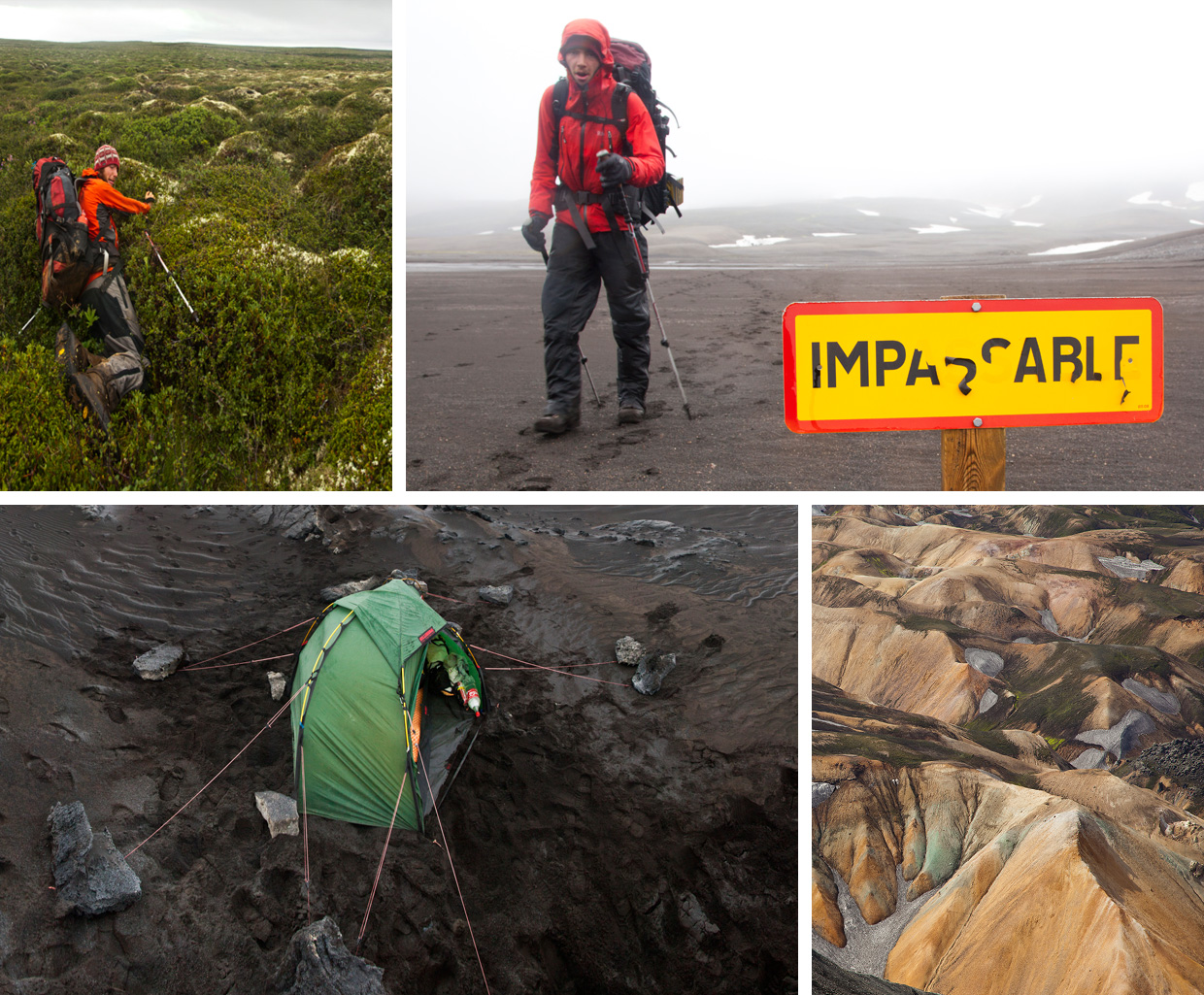
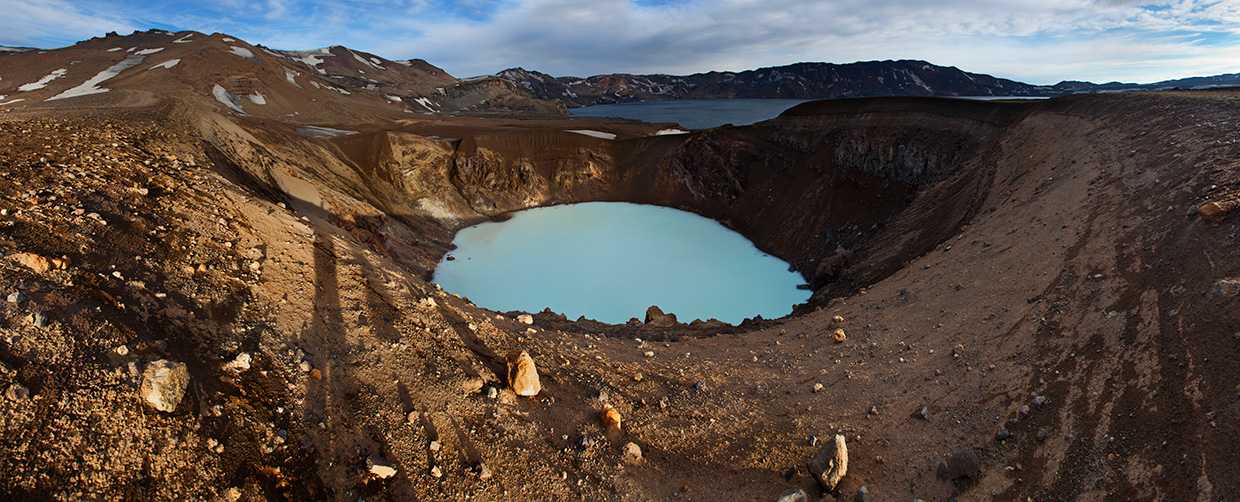
Each day we would crawl from the warm comfort of our sleeping bags and into cold wet clothes, the climate seemed unforgiving and relentlessly wet and a stiff wind blew cold from the Vatnajokull glacier. Returning to the F26 from behind a sign which satisfyingly read “UNPASSABLE” we rejoiced. Askja was only a few days away!
Skirting the Vatnajokull glacier itself we aimed for a peak on the map, to your surprise it was non-existent. It was good visibility, the GPS confirmed we were in close sight of the summit but it just wasn’t there! After a lot of head scratching and searching we found out why…the peak wasn’t a peak at all, it was a crater!
Back on track, we crossed into a sea of perfect flat ash, the outwash plains of the north. Here hiking became a mental game, the weather still harsh the horizon seemed to be ever distant, in the huge scale of the desert it was hard to measure progress. At last after a 2km wide shallow river crossing we squelched into the hut at Askja, it had been a 40km long day but worth every strain for the warm fire.
At the edge of the gigantic explosion crater known as the Askja caldera the hut provided a superb days rest and after many days alone the luxury of company. Housing a lake 200m deep Askja is the deepest inland water body in Iceland, on the fringes of Europe’s largest cold desert, Europe’s largest lava flow and in sight of Europe’s largest glacier it was an inspiring spectacle. Sulphur and steam spewed from vents and a small crater lake known as Viti offered a 27ºC swimming pool for the evening. More importantly we were just three days from Myvatn…we had almost survived the Interior!
Eager to arrive to civilization we set off across the vast lava field which stood between Lake Myvatn and us. It was one of the toughest day’s hiking I have ever experienced. Razor sharp scoria bore deeply into my hands and feet. Brittle and jagged, it cracked and rolled underfoot making each placement unstable and challenging. Often I would haul my knees high over large boulders to heave my heavy pack across the difficult terrain. Slowly the scoria turned to ropey pavements and deep cracked fissures, although easier to walk on climbing and weaving made progress slow across the challenging terrain. We were motivated with the distant glimpse of green fields, we knew behind the far hills the Arctic sea crashed against the northern shores of Iceland. We were nearly there!
Descending from the desert toward lake Myvatn the terrain suddenly changed, we found ourselves in thick grassland browned by the sun, gnarled birch trees stood alone sculpted by the wind and wide craters dotted the landscape. It felt more like the African Savanna than northern Iceland. Emerging at last onto the first tarmac road in weeks we had made it! A single car passed, stood like deer in the headlights we watched as it sped past the thought of such speed seemed almost distant.
From here it was all down hill, in less than a week we would have finished our journey. There was no longer doubt in my mind that we would succeed. To reach the coast we joined the mighty Jökulsá á fjöllum river. A turbulent glacial outwash the river is the second longest in Iceland at 206km, it is also home to Europe’s highest volume waterfall Dettifoss. It was here where we joined, as we approached the roar of falling water lead our way toward the gorge, it was an incredible sight. From the gigantic surge plummeting over a tall cliff curtains of ghostly mist floated gracefully upward to vibrant moss lined canyon walls. Below the falls muddy rapids plunged over falls broken only by crystal blue springs which joined from deep valleys at the gorge’s edge. As we scrambled down and hopped over deep fissures and columnar basalt it was easy to imagine the fairies and trolls of Icelandic folklore peering up at the two dusty and smelly visitors to their pristine world.
Smiling and happy we descended, at last we were in sight of the sea! Huge cliffs and expanses of black ashen beaches with pearl white waves crashing upon them with the tranquil fury of the ocean beckoned us onward.
Day 27, our final day and a long one at that. With determined energy we left the road and begun to wander across deep mossy hummocks which lined 40km of perfect flat grassy plains. We were searching for a seemingly mythical horse track which according to a local would lead us directly to the north. Hours seemed to go by, each step would be a high reach to clamber over the deep hummocky ground, we wound past lakes and eventually begun to traverse along a power line.
With relief and only 15km to go we stumbled across a small muddy trail, it lead directly north…this was it! Already late in the day a sea harr had begun to drift across the grassland, through the fog we plodded on. The ocean came into sight and soon after a small white pillar in the distance. Hraunhafnartangi was our finish line, the north of Iceland.
Late in the evening Remi and I triumphantly staggered onto the beach, along a grassy track and collapsed exhausted at the base of the lighthouse. There was no crowd, no applause we just sat there content in silence. We had made it!

Will is a Student at the University of Stirling, studying Environmental Science and Outdoor Education. At 22 years old Will is an avid hiker, kayaker and photographer. His love of the outdoors started from an early age. Growing up in the North West highlands of Scotland Will was immersed in Sailing, Kayaking, Cycling and hiking. Encouraged by a loving family and the local field club a love of natural history developed.
Now approaching his final year at university Will is focusing on pursuing a career in photography, and is currently on his next expedition, a solo sea kayak journey around Scotland followed by the summing of all the Scottish “Munros” (mountains over 3000ft) using only a bicycle to travel between.
Website:willcopestakemedia.com/
Twitter: twitter.com/WillCopestake
Facebook: facebook.com/WillCopestakeMedia




